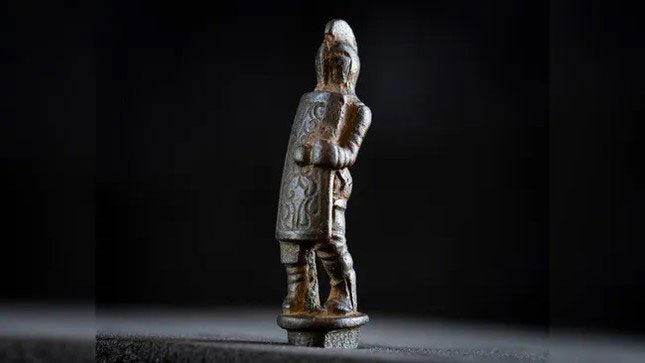It is rare to find memorabilia from Roman-era gladiators in England, but archaeologists at Hadrian’s Wall in Northumberland, England, have recently discovered a 2,000-year-old knife handle depicting a left-handed gladiator.
Archaeologists in England have uncovered a rare 2,000-year-old Roman knife handle shaped like a gladiator, proving that the fame of these iconic warriors reached the farthest edges of the Roman Empire. This discovery comes just in time for the release of the highly anticipated film “Gladiator II”.

The Roman knife handle depicting a secutor gladiator found in the Roman Town of Corbridge on Hadrian’s Wall in Northumberland, England. (Photo: English Heritage).
The handle is made of a bronze alloy and features a gladiator wearing a helmet and holding a shield. This small statue represents the secutor gladiator, a type of heavily armed fighter whose name comes from Latin, meaning “the pursuer”, who specialized in close combat against the more agile retiarius gladiator, who wielded a net and trident.
This depiction of a gladiator is left-handed. According to a statement from English Heritage, the charity that oversees historical sites in England, left-handed gladiators were considered unlucky, though some were trained to fight left-handed to gain a unique advantage. In this case, researchers suggest that this characteristic might indicate that the gladiator represents a specific individual rather than being a symbolic warrior.
In ancient Rome, gladiatorial games were one of the most popular forms of public entertainment. Gladiators were often slaves or convicted criminals, and contests sometimes ended with the death of a gladiator. These games were organized by members of the Roman elite, including the emperor himself, to showcase their wealth, celebrate special occasions, and entertain the public. While the Colosseum in Rome is the most famous venue for such contests, they officially took place throughout the empire from 105 BC to AD 404.
Frances McIntosh, Manager of the Hadrian’s Wall Collection at English Heritage, stated: “Although enslaved and ostracized by society for their profession, gladiators could still become celebrities.”
According to the statement, the knife handle is clearly a relic of a Roman gladiator. While memorabilia from gladiators has been well-documented, including pottery, cups, lamps, and figurines, this is a rare archaeological find in England. This discovery highlights the widespread enthusiasm for gladiators.
McIntosh further noted: “Even now, nearly two thousand years later, the fascination with gladiators persists and has even expanded into modern popular culture, as evidenced by the excitement surrounding the sequel to the Gladiator film.”




















































